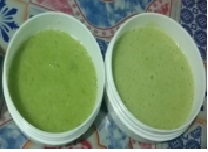Bioactive Compounds and Microbacteria of Peel-Off Gel Mask Caulerpa racemosa
Abstract
Caulerpa racemosa is a type of seaweed that has the potential to be cultivated because it is known and favored by the public.Caulerpa racemosa is used not only for consumption as food but also for beauty cosmetics because of its ingredients. This study aims to determine the Bioactive content and total plate count (TPC) of the Caulerpa racemosa peel-off gel mask. The pour plate method was used to determine the total plate number of mycobacteria and phytochemical testing in the form of tests for flavonoid, alkaloid, phenolic, tannin, triterpenoids, and saponin. The results showed that the total colony total plate count until the 3rd repetition had an average of 31 col/g. The results of the phytochemical test of the Caulerpa racemosa peel-off gel mask contained bioactive compounds: flavonoid, alkaloid, phenolic, tannins, triterpenoid, and saponin. Conclusion: The Total plate count of Caulerpa racemosa peel off the gel mask complies with Indonesian National standards (INS) with the content of bioactive compounds, namely tannins dan saponins. Caulerpa racemose was used for a pell-off gel mask for the first time.
Downloads

Copyright (c) 2023 Tri Widayati Putri, Mutemainna Karim, Zul Khairiyah, Andi Fitri Ramadhani

This work is licensed under a Creative Commons Attribution-NonCommercial-NoDerivatives 4.0 International License.
Authors who publish with this journal agree to the following terms:
- Copyright on any article is retained by the author(s).
- The author grants the journal, the right of first publication with the work simultaneously licensed under a Creative Commons Attribution License that allows others to share the work with an acknowledgment of the work’s authorship and initial publication in this journal.
- Authors are able to enter into separate, additional contractual arrangements for the non-exclusive distribution of the journal’s published version of the work (e.g., post it to an institutional repository or publish it in a book), with an acknowledgment of its initial publication in this journal.
- Authors are permitted and encouraged to post their work online (e.g., in institutional repositories or on their website) prior to and during the submission process, as it can lead to productive exchanges, as well as earlier and greater citation of published work.
- The article and any associated published material is distributed under the Creative Commons Attribution-NonCommercial-NoDerivatives 4.0 International License.





_copy1.png)










